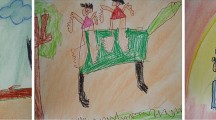Abstract
This article reports findings from a diverse third grade classroom that integrates a literacy through photography (LTP) curriculum as a central component of writing instruction in an urban public school. A case study approach was used in order to provide an in-depth, multi-dimensional consideration of phenomena by drawing on multiple data sources to examine and describe the LTP program in this third grade classroom. Data were gathered, on average twice a week, throughout a full school year. The findings of this study demonstrate how utilizing different forms of communication, such as photography, alongside traditional school literacies, such as writer’s workshop, expands the options that children have of processing and expressing their understanding.
Similar content being viewed by others
References
Albers, P., & Cowan, K. (2006). Literacy on our minds: A student-inspired symposium. Language Arts, 83(6), 514–522.
Albers, P., & Harste, J. C. (2007). The arts, new literacies, and multimodality. English Education, 40(1), 6–20.
Allen, J., Fabregas, V., Hankins, K. H., Hull, G., Labbo, L., & Lawson, H. S. (2002). PhOLKS lore: Learning from photographs, families, and children. Language Arts, 79(4), 56–60.
Allington, R. L., & Cunningham, P. M. (2002). Schools that work: Where all children read and write. New York: Allyn & Bacon.
Bezemer, J., & Kress, G. (2008). Writing in multimodal texts: A social semiotic account of designs for learning. Written Communication, 25(2), 166–195.
Cappello, M. (2006). Under construction: Voice and identity development in writing workshop. Language Arts, 83(6), 482–491.
Cappello, M., & Hollingsworth, S. (2008). Literacy inquiry and pedagogy through a photographic lens. Language Arts, 85(6), 442–449.
Creswell, J. W. (2013). Research design: Qualitative, quantitative, and mixed methods approaches. Thousand Oaks: Sage.
Dyson, A. H., & Genishi, C. (2005). On the case: Approaches to language and literacy research. New York: Teachers College Press.
Ewald, W. (2002). The best part of me: Children talk about their bodies in pictures and words. New York: Little, Brown Books for Young Readers.
Greene, M. (2000). Releasing the imagination: Essays on education, the arts, and social change. San Francisco, CA: Jossey-Bass.
Hassett, D. D., & Curwood, J. S. (2009). Theories and practices of multimodal education: The instructional dynamics of picture books and primary classrooms. The Reading Teacher, 63(4), 270–282.
Hilden, K. R., & Pressley, M. (2007). Self-regulation through transactional strategies instruction. Reading & Writing Quarterly, 23(1), 51–75.
Jewett, C. (Ed.). (2009). The Routledge handbook of multimodal analysis. London: Routledge.
Keat, J. B., Strickland, M. J., & Marinak, B. A. (2009). Child voice: How immigrant children enlightened their teachers with a camera. Early Childhood Education Journal, 37(1), 13–21.
Kress, G. R. (1997). Before writing: Rethinking the paths to literacy. London: Routledge.
Kress, G. R. (2003). Literacy in the new media age. London: Routledge.
Kress, G. R. (2010). Multimodality. A social semiotic approach to contemporary communication. London: Routledge.
Krueger, R. A., & Casey, M. A. (2009). Focus groups: A practical guide for applied research. Thousand Oaks: Sage.
Mavers, D. (2007). Semiotic resourcefulness: A young child’s email exchange as design. Journal of Early Childhood Literacy, 7(2), 155–176.
Merriam, S. B. (2014). Qualitative research: A guide to design and implementation. New York: Wiley.
Moline, S. (2011). I see what you mean: Visual literacy K-8. York, ME: Stenhouse.
Moran, M. J., & Tegano, D. W. (2005). Moving toward visual literacy: Photography as a language of teacher inquiry. Early Childhood Research & Practice, 7(1). Retrieved July 13, 2014, from http://ecrp.uiuc.edu/v7n1/moran.html.
Pahl, K., & Rowsell, J. (2005). Literacy and education. Understanding the new literacies studies in the classroom. London: Paul Chapman.
Ranker, J. (2009). Redesigning and transforming: A case study of the role of semiotic import in early composing processes. Journal of Early Childhood Literacy, 9(3), 319–347.
Rose, G. (2008). Using photographs as illustrations in human geography. Journal of Geography in Higher Education, 32(1), 151–160.
Rowsell, J., McLean, C., & Hamilton, M. (2012). Visual literacy as a classroom approach. Journal of Adolescent & Adult Literacy, 55(5), 444–447.
Schellings, G., Aarnoutse, C., & van Leeuwe, J. (2006). Third-graders’ think-aloud protocols: Types of reading activities in reading an expository text. Learning and Instruction, 16(6), 549–568.
Schofield, D., & Kupiainen, R. (2015). Young people’s narratives of media and identity. Nordicom Review, 36(1), 79–93.
Serafini, F. (2014). Reading the visual: An introduction to teaching multimodal literacy. New York: Teachers College Press.
Siegel, M. (2006). Review of research: Rereading the signs: Multimodal transformation in the field of literacy education. Language Arts, 84(1), 65–77.
Stake, R. E. (1995). The art of case study research. Thousand Oaks, CA: Sage.
Stein, P. (2008). Multimodal instructional practices. In J. Coiro, M. Knobel, C. Lankshear, & D. J. Leu (Eds.), Handbook of research on new literacies (pp. 871–898). New York: Lawrence Erlbaum Associates.
Wissman, K. (2008). “This is what I see”: (Re)envisioning photography as a social practice. In M. Hill & L. Vasudevan (Eds.), Media, learning, and sites of possibility (pp. 13–45). New York: Peter Lang.
Yin, R. K. (2013). Case study research: Design and methods. Thousand Oaks, CA: Sage.
Young, K. A. (2005). Direct from the source: The value of ‘think-aloud’ data in understanding learning. Journal of Educational Inquiry, 6(1), 19–33.
Zenkov, K., & Harmon, J. (2009). Picturing a writing process: Photovoice and teaching writing to urban youth. Journal of Adolescent & Adult Literacy, 52(7), 575–584.
Author information
Authors and Affiliations
Corresponding author
Rights and permissions
About this article
Cite this article
Wiseman, A.M., Mäkinen, M. & Kupiainen, R. Literacy Through Photography: Multimodal and Visual Literacy in a Third Grade Classroom. Early Childhood Educ J 44, 537–544 (2016). https://doi.org/10.1007/s10643-015-0739-9
Published:
Issue Date:
DOI: https://doi.org/10.1007/s10643-015-0739-9




